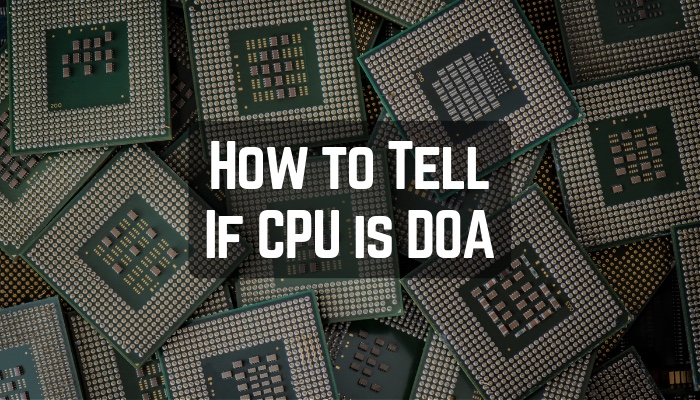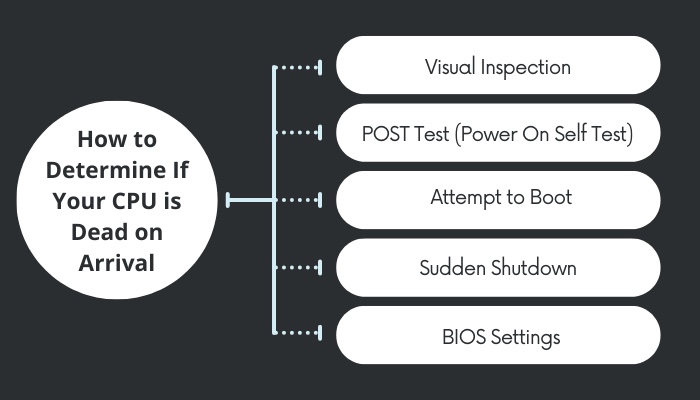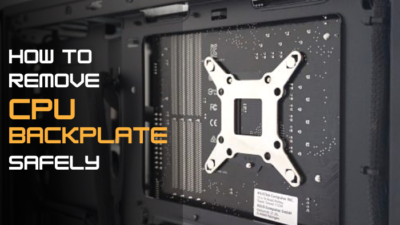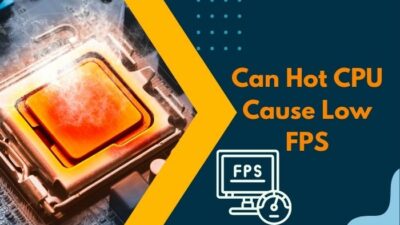Having a dead-on-arrival CPU can be a frustrating experience, especially when you’re building a new computer or upgrading an existing one.
If your CPU doesn’t work, any other component won’t work as it should. However, other faulty hardware can also cause similar issues. So, how can you know if your CPU is DOA?
Well, don’t worry. Here I’ll show you how to detect a DOA CPU and the steps you can take to resolve the issue.
So, let’s jump in.
How to Determine If Your CPU is Dead on Arrival
DOA, aka Dead On Arrival, describes the conditions of a computer or PC hardware when you first receive it. You can easily determine if your CPU is DOA or not by simply plugging and playing. If you were able to get into BIOS and run tests, your CPU is in good condition.
In this section, I will show you how you can identify a DOA CPU. Let’s see how to do it.
Here are the methods to identify a dead-on-arrival (DOA) CPU:
1. Visual Inspection
While checking for CPU DOA errors, you need to look if there are any physical damages or deformations on the CPU. Because physical damage is the main reason for processor DOA. So compare the CPU with its original looks after opening the package.
2. POST Test (Power On Self Test)
Power On Self Test verifies whether the CPU connected to your motherboard is working or not. You can perform this POST test using the computer’s BIOS. If the POST fails, the computer will not boot or display an error message CPU is not functioning properly.
From there, you can be sure your CPU is dead.
3. Attempt to Boot
If your PC fails to boot up or freezes at a certain point, there is a problem with the CPU. In that case, you need to use your CPU on another PC. If the issue remains, then your CPU is faulty.
4. Sudden Shutdown
While using your device, if your pc shows error messages like CPU not functional or overheating, there is some issue with your CPU. However, if your PC suddenly shuts down and you can’t turn it on again, your CPU can get a DOA error.
5. BIOS Settings
You should enter the BIOS and check the CPU settings to ensure the motherboard recognizes your CPU and it functions properly. If not, then your CPU may have some issues.
These are the general methods to tell if your CPU is DOA. But you may not apply it to every computer or CPU. So, if you are unsure, it is best to consult a professional or the manufacturer for further assistance.
On a side note, you should check out our detailed discussion on whether thermal paste can damage the CPU or not.
What Can Cause a DOA CPU?
Usually, physical damage like bend pins, damage in IHS, SMD wreck, or unintentional rub-in the processor surface connector can cause the dead-on-arrival issue in your CPU. Because these kinds of damage can hurt the DIE of your processor. Also, some errors in the factory can cause DOA CPU.
In this portion, I will show you some key reasons that can cause CPU dead-on-arrival problems. It will help you to identify your CPU fault and quickly replace it.
Below are the reasons that can cause the CPU DOA issue:
- If your CPU has some bend connector pins, it can be dead. You shouldn’t mount that CPU in your motherboard.
- When the CPU IHS has some dent on the surface, it can damage the DIE inside, making the CPU dead.
- SMD damage can be responsible for a damaged CPU.
- The processor won’t work on your motherboard if you accidentally hard-rub the CPU connector. So make sure to clean your CPU adequately.
These are some reasons that can make your CPU dead. Additionally, dropping the CPU package during delivery can also result in a DOA processor. Read the following section to know what you can do to fix the DOA CPU.
How to Fix Your Defect on Arrival CPU
Unfortunately, there isn’t any way to fix the CPU DOA problem. All you can do is ask for a refund or claim the replacement warranty.
Luckily, if you get a faulty CPU or any parts that break within 30 days of the delivery date, you will get a replacement from the retailer. Also, here’s our in-depth guide on whether a damaged CPU can still work or not.
FAQs
Can a CPU be DOA?
Yes, your CPU can be DOA, but it’s very rare. Because the CPU goes through some extensive tests before manufacturers release them in the market.
How common is a DOA CPU?
CPU DOA is a very rare problem, but possible. Because the CPU is more sturdy than any other PC component available in the market.
Does the DOA part have warranties?
Yes, you will get a replacement warranty. If you get faulty items or any parts that break within 30 days of the delivery date, you can consider them Dead on Arrival (DOA). Any DOA part has a 30 days replacement warranty.
Conclusion
In short, the CPU is like the brain of your computer. It’s common sense; if your brain is dead, then none of your body parts will work. Just like that, your PC will not open on a dead CPU. Sadly, there isn’t any way to fix dead-on-arrival CPUs. You can only replace the hardware.
After reading the article, I’m sure you know the method to check any dead/damaged CPU on arrival. Comment if you have any other queries about PC hardware. Peace!




